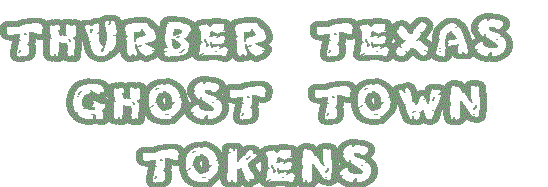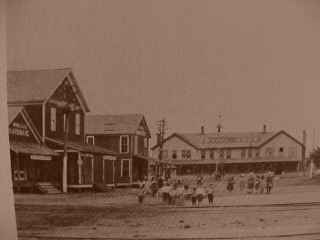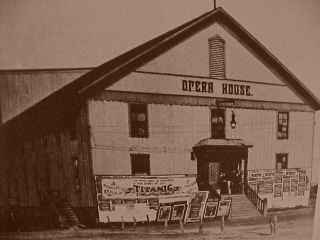

PAGE 21

Copyright © 1998 all rights reserved
In memory of Bill Fowler
The token:
T. P. M. & M. CO. / THURBER, / TEXAS.
GOOD FOR / ONE STICK / DYNAMITE
Brass-round-31mm (circa: 1887-1920, estimated value : $100-$200) (also known in aluminum) (Texas Pacific Mercantile and Manufacturing Company)


The remains of Thurber, Texas are located in the northwestern portion of Erath County, about 75 miles west of Fort Worth. Few people outside of northern Texas have ever heard of this old ghost town. The town was born in 1885, and pretty much had died as a town by the late 1930’s.
A BRIEF HISTORY OF THURBER
The early surveyors of Palo Pinto Country Texas noted coal outcroppings among the rocks in many places. The most noted of these was on the western edge of Clayton Mountain. The first coal mining effort in the area was early in the year of 1881 by the James, Cowan and Nolton Company, when they opened a drift mine about two miles north of the railroad, on the west side of Clayton Mountain. This was called the Gordon Mine, and later the community at the mine was called "Coalville."
In 1886, William Whipple Johnson discovered coal on a farm in Erath County. In December of 1886, Johnson and his brother Harvey sank a shaft 52 feet into the seam of coal in that secluded valley, and named their venture the Johnson Coal Company. In March of 1888, Harvey Johnson died, leaving William to close the mine in October of 1888. Robert D. Hunter, Edgar Marston, and Horace Thurber formed a company named the Texas and Pacific Coal Company, named for the nearby railroad, but not having any ties to the railroad. In November of 1888, the TPCC bought 2,302 acres of the Johnson Mines land, plus an adjoining 20,398 acres of land. Johnson went on to open coal mines at Lyra and Strawn, Texas. The union problems at Thurber would make a long story by itself. Suffice it to say that there was much union trouble over the years. Despite that, coal production was constant, and reached a peak in 1919 of 3,000 tons per day.
The #9 Mine  at Thurber
at Thurber
Thurber was at one time a completely fenced-in town. The Texas and Pacific Coal Company provided everything for the workers, cradle to grave. The population of Thurber was as many as 9,000 as one time. In the year 1890, the population was estimated at 1,500 persons, 800 blacks and 700 whites. Over the life of the town, the proportion of various ethnic groups varied widely depending on what union tactic the "company" was attempting to squash. Records show that of the men of 16 European nations who achieved citizenship in Thurber, the majority were either of Polish or Italian ancestry, with Italians leading two to one (was the reason the nearby mining town was named Lyra due to the similarity of the Italian words "lira" and "lire"?). Thurber did boast of various niceties of life, including an opera house, a public library, and free public schools. There was also a low cost private school available for children of the miners.

The Knox Hotel was hosting travelers at only $2.50 per night, a musical band was formed, baseball team, fishing and boating clubs, four churches, 6 fraternal lodges, and 7 African-American orders. In 1897, a brick making plant was built, which over the years provided brick for many buildings and streets in surrounding counties. Thurber also had its own hospital, dairy, ice plant, cotton gin, and most amenities. All Thurberites were not poor, as evidenced by a clothing drive in World War I, that netted 4 dozen mink coats.
THE USE OF TOKENS AND SCRIP IN THURBER
In 1905, the average Thurber coal miner earned $54 per month. He was allowed to draw company scrip, in the form of coupon books, in advance of salary to spend at the company store. From his $54 each month the company deducted from 6 to 9 dollars for rent, one dollar for transportation to the mines, fifty cents for the hospital fund, two dollars for water, and the amount of scrip advanced from the previous month. The company store was called The Texas and Pacific Mercantile and Manufacturing Company, or T.P.M. & M. Its life span was from 1894 to 1933. The majority of the TPM&M Company’s business was conducted using paper scrip, or "check" as the miners called it. Originally the paper scrip was printed in New York, as coupon books of value from $1.00 to $10.00. Later, the company purchased the necessary equipment and began printing their own paper scrip in Thurber. It was numbered using a Bates Numbering Machine. Once a month, the paper scrip that had accumulated in the company stores was taken to the brickyard and burned in the brick kilns, under the supervision of armed guards.
The use of metal checks or tokens was limited. Miners used steel washers with their number stamped on them as tallies on coal cars. Metal trade tokens have been reported from The Snake Saloon in Thurber, and brass and aluminum dynamite tokens are known from the TPM&M Company. Dynamite was used for "back brushing", or blasting the roof away from the tunnel to allow room for loading coal into cars. Miners used both black powder and dynamite to dislodge coal from the mine. If a miner’s supply of black powder or dynamite were depleted, he would turn in his order at the mine office as he left work in the evening. The explosive would be delivered by the company and waiting for him at the mine the next morning. The cost of the explosives was paid by the miner and deducted from his monthly salary.
SALOONS IN AND NEAR THURBER
Jimmy Grant opened a saloon east of the town of Thurber (pre 1893), which became popular with the miners. After repeated raids by Erath County lawmen, Grant moved his saloon in 1893 to a location in Palo Pinto County, three quarters of a mile north of Thurber, just off the coal companies property. The Grant Saloon was sold to Bruce and Stewart (D. W. Stewart) who continued the business. The company had at least two saloons in town, the most famous was the "Snake Saloon" and the other was the "Lizard Saloon."

THE SLOW DEATH OF THURBER
While drilling for coal in the early days of Thurber, oil had been found. Although the first well was started in 1900, it wasn’t completed until 1915. Initial production was 60 barrels per day. Coal production slowed, and finally ended in 1926. The emphasis had shifted from coal to oil, and the most of the oil production was in Ranger, not in Thurber. The company became Texas Pacific Oil Company, and drilled 1,364 wells, and hit producing oil in 1,123 of that number. They owned wells in 8 states and two countries, and leases for production in 23 states. Today, all that remains of once thriving Thurber is the brick smokestack from the power plant (rising 126.1 feet above the ground), water treatment plant, fire station, several homes and some ruins. So if you make a trip to Thurber in search of tokens, don’t forget the ghosts come out at dusk!
References: "Fire in a Hole" by Weldon B. Hardman, 1975; "Handbook of Texas" by The Texas State Historical Association; "Too Tough To Quit" (article in True West Magazine) by Cindi Myers; "Off the Beaten Trail, Volume 1" by Ed Syers.
Here is a link to a website on Thurber:
on to page 22 of our token web pages....
updated 4 Oct 2002